Deck 2: Functions and Graphs
سؤال
سؤال
سؤال
سؤال
سؤال
سؤال
سؤال
سؤال
سؤال
سؤال
سؤال
سؤال
سؤال
سؤال
سؤال
سؤال
سؤال
سؤال
سؤال
سؤال
سؤال
سؤال
سؤال
سؤال
سؤال
سؤال
سؤال
سؤال
سؤال
سؤال
سؤال
سؤال
سؤال
سؤال
سؤال
سؤال
سؤال
سؤال
سؤال
سؤال
سؤال
سؤال
سؤال
سؤال
سؤال
سؤال
سؤال
سؤال
سؤال
سؤال
سؤال
سؤال
سؤال
سؤال
سؤال
سؤال
سؤال
سؤال
سؤال
سؤال
سؤال
سؤال
سؤال
سؤال
سؤال
سؤال
سؤال
سؤال
سؤال
سؤال
سؤال
سؤال
سؤال
سؤال
سؤال
سؤال
سؤال
سؤال
سؤال
سؤال

فتح الحزمة
قم بالتسجيل لفتح البطاقات في هذه المجموعة!
Unlock Deck
Unlock Deck
1/178
العب
ملء الشاشة (f)
Deck 2: Functions and Graphs
1
Use point-by-point plotting to sketch the graph of the equation.
-y = x + 3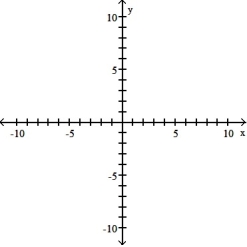
A)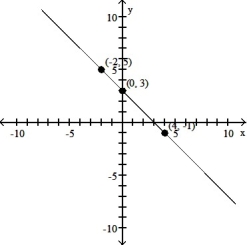
B)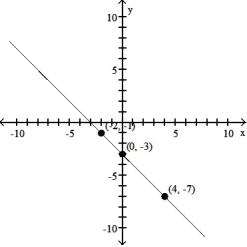
C)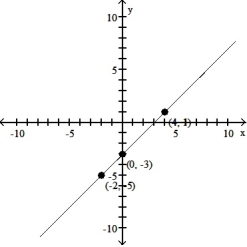
D)
-y = x + 3

A)

B)

C)

D)


2
Use point-by-point plotting to sketch the graph of the equation.
-
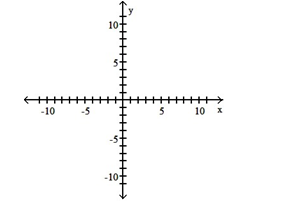
A)
B)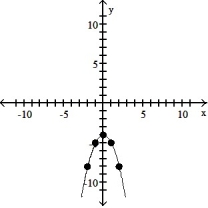
C)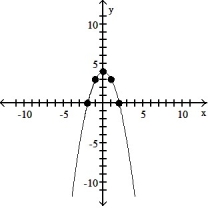
D)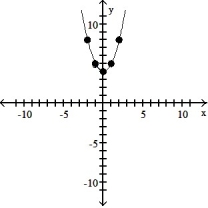
-


A)

B)

C)

D)


3
Determine whether the graph is the graph of a function.
-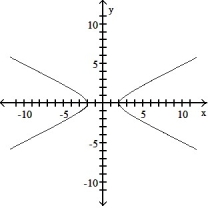
A) function
B) not a function
-

A) function
B) not a function
not a function
4
Determine whether the graph is the graph of a function.
-
A) function
B) not a function
-

A) function
B) not a function

فتح الحزمة
افتح القفل للوصول البطاقات البالغ عددها 178 في هذه المجموعة.
فتح الحزمة
k this deck
5
Determine whether the graph is the graph of a function.
-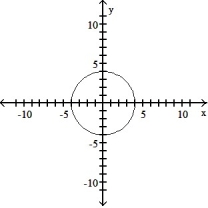
A) function
B) not a function
-

A) function
B) not a function

فتح الحزمة
افتح القفل للوصول البطاقات البالغ عددها 178 في هذه المجموعة.
فتح الحزمة
k this deck
6
Determine whether the relation represents a function. If it is a function, state the domain and range.
-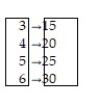
A) function
Domain:{15, 20, 25, 30}
Range: { 3, 4, 5, 6}
B) function
Domain: { 3, 4, 5, 6}
Range: {15, 20, 25, 30}
C) not a function
-

A) function
Domain:{15, 20, 25, 30}
Range: { 3, 4, 5, 6}
B) function
Domain: { 3, 4, 5, 6}
Range: {15, 20, 25, 30}
C) not a function

فتح الحزمة
افتح القفل للوصول البطاقات البالغ عددها 178 في هذه المجموعة.
فتح الحزمة
k this deck
7
Determine whether the relation represents a function. If it is a function, state the domain and range.
-
A) function
Domain: { carrots, peas, squash}
Range: { Bob, Ann, Dave}
B) function
Domain: { Bob, Ann, Dave}
Range: { carrots, peas, squash}
C) not a function
-

A) function
Domain: { carrots, peas, squash}
Range: { Bob, Ann, Dave}
B) function
Domain: { Bob, Ann, Dave}
Range: { carrots, peas, squash}
C) not a function

فتح الحزمة
افتح القفل للوصول البطاقات البالغ عددها 178 في هذه المجموعة.
فتح الحزمة
k this deck
8
Determine whether the relation represents a function. If it is a function, state the domain and range.
-{( 41, -2), ( 5, -1), ( 5, 0), ( 6, 1), ( 14, 3)}
A) function
Domain: { 41, 6, 5, 14}
Range: { -2, -1, 0, 1, 3}
B) function
Domain: { -2, -1, 0, 1, 3}
Range: { 41, 6, 5, 14}
C) not a function
-{( 41, -2), ( 5, -1), ( 5, 0), ( 6, 1), ( 14, 3)}
A) function
Domain: { 41, 6, 5, 14}
Range: { -2, -1, 0, 1, 3}
B) function
Domain: { -2, -1, 0, 1, 3}
Range: { 41, 6, 5, 14}
C) not a function

فتح الحزمة
افتح القفل للوصول البطاقات البالغ عددها 178 في هذه المجموعة.
فتح الحزمة
k this deck
9
Determine whether the relation represents a function. If it is a function, state the domain and range.
-{( -2, 2), ( -1, -1), (0, -2), ( 1, -1), ( 3, 7)}
A) function
Domain: { -2, -1, 0, 1, 3}
Range: { 2, -1, -2, 7}
B) function
Domain: { 2, -1, -2, 7}
Range: { -2, -1, 0, 1, 3}
C) not a function
-{( -2, 2), ( -1, -1), (0, -2), ( 1, -1), ( 3, 7)}
A) function
Domain: { -2, -1, 0, 1, 3}
Range: { 2, -1, -2, 7}
B) function
Domain: { 2, -1, -2, 7}
Range: { -2, -1, 0, 1, 3}
C) not a function

فتح الحزمة
افتح القفل للوصول البطاقات البالغ عددها 178 في هذه المجموعة.
فتح الحزمة
k this deck
10
Determine whether the function is linear, constant, or neither:
-
A) Linear
B) Constant
C) Neither
-

A) Linear
B) Constant
C) Neither

فتح الحزمة
افتح القفل للوصول البطاقات البالغ عددها 178 في هذه المجموعة.
فتح الحزمة
k this deck
11
Determine whether the function is linear, constant, or neither:
-
A) Linear
B) Constant
C) Neither
-

A) Linear
B) Constant
C) Neither

فتح الحزمة
افتح القفل للوصول البطاقات البالغ عددها 178 في هذه المجموعة.
فتح الحزمة
k this deck
12
Determine whether the function is linear, constant, or neither:
-
A) Linear
B) Constant
C) Neither
-

A) Linear
B) Constant
C) Neither

فتح الحزمة
افتح القفل للوصول البطاقات البالغ عددها 178 في هذه المجموعة.
فتح الحزمة
k this deck
13
Use point-by-point plotting to sketch the graph of the equation.
-
A)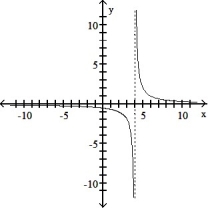
B)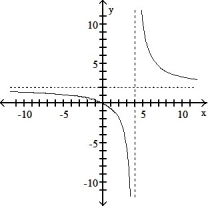
C)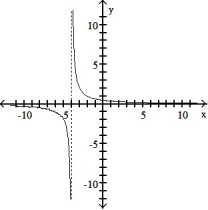
D)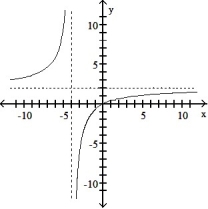
-

A)

B)

C)

D)


فتح الحزمة
افتح القفل للوصول البطاقات البالغ عددها 178 في هذه المجموعة.
فتح الحزمة
k this deck
14
The graph of a function f is given. Use the graph to answer the question.
-Use the graph of f given below to find f( 10).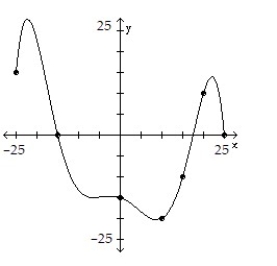
A) 10
B) -20
C) 0
D) 15
-Use the graph of f given below to find f( 10).

A) 10
B) -20
C) 0
D) 15

فتح الحزمة
افتح القفل للوصول البطاقات البالغ عددها 178 في هذه المجموعة.
فتح الحزمة
k this deck
15
Find the function value:
-Find f( 4) when
A) 137
B) -119
C) -23
D) -55
-Find f( 4) when

A) 137
B) -119
C) -23
D) -55

فتح الحزمة
افتح القفل للوصول البطاقات البالغ عددها 178 في هذه المجموعة.
فتح الحزمة
k this deck
16
Find the function value:
-
A)
B)
C)
D)
-

A)

B)

C)

D)


فتح الحزمة
افتح القفل للوصول البطاقات البالغ عددها 178 في هذه المجموعة.
فتح الحزمة
k this deck
17
Find the function value:
-Given that , find f(t + 2).
, find f(t + 2).
A)
B)
C) 3t + 6
D)
-Given that
 , find f(t + 2).
, find f(t + 2).A)

B)

C) 3t + 6
D)


فتح الحزمة
افتح القفل للوصول البطاقات البالغ عددها 178 في هذه المجموعة.
فتح الحزمة
k this deck
18


فتح الحزمة
افتح القفل للوصول البطاقات البالغ عددها 178 في هذه المجموعة.
فتح الحزمة
k this deck
19


فتح الحزمة
افتح القفل للوصول البطاقات البالغ عددها 178 في هذه المجموعة.
فتح الحزمة
k this deck
20


فتح الحزمة
افتح القفل للوصول البطاقات البالغ عددها 178 في هذه المجموعة.
فتح الحزمة
k this deck
21
Compute and simplify the difference quotient 
-
A) 10x + 7
B) 10x + 5h + 7
C)
D) 15x - 7h + 14

-

A) 10x + 7
B) 10x + 5h + 7
C)

D) 15x - 7h + 14

فتح الحزمة
افتح القفل للوصول البطاقات البالغ عددها 178 في هذه المجموعة.
فتح الحزمة
k this deck
22
Determine the domain of the function:
-f(x) = - 7x + 9
A) No solution
B)
C) All real numbers
D)
-f(x) = - 7x + 9
A) No solution
B)

C) All real numbers
D)


فتح الحزمة
افتح القفل للوصول البطاقات البالغ عددها 178 في هذه المجموعة.
فتح الحزمة
k this deck
23
Determine the domain of the function:
-
A) No solution
B) All real numbers except 2
C) All real numbers
D) x < 2
-

A) No solution
B) All real numbers except 2
C) All real numbers
D) x < 2

فتح الحزمة
افتح القفل للوصول البطاقات البالغ عددها 178 في هذه المجموعة.
فتح الحزمة
k this deck
24
Determine the domain of the function:
-
A) x ? 3
B) All real numbers except 3
C) x < 3
D) No solution
-

A) x ? 3
B) All real numbers except 3
C) x < 3
D) No solution

فتح الحزمة
افتح القفل للوصول البطاقات البالغ عددها 178 في هذه المجموعة.
فتح الحزمة
k this deck
25
Determine the domain of the function:
-
A) All real numbers
B) x < 0
C) No solution
D) All real numbers except 0
-

A) All real numbers
B) x < 0
C) No solution
D) All real numbers except 0

فتح الحزمة
افتح القفل للوصول البطاقات البالغ عددها 178 في هذه المجموعة.
فتح الحزمة
k this deck
26
Only one of the following functions has domain which is not equal to all real numbers. State which function and state its domain.
A)
B)
C)
A)

B)

C)


فتح الحزمة
افتح القفل للوصول البطاقات البالغ عددها 178 في هذه المجموعة.
فتح الحزمة
k this deck
27
Determine if the equation specifies a function with independent variable x. If so, find the domain. If not, find a value of x to which there corresponds more than one value of y:
-
A) A function with domain ℛ
B) Not a function; for example, when x = 10, y = ±1
-

A) A function with domain ℛ
B) Not a function; for example, when x = 10, y = ±1

فتح الحزمة
افتح القفل للوصول البطاقات البالغ عددها 178 في هذه المجموعة.
فتح الحزمة
k this deck
28
Determine if the equation specifies a function with independent variable x. If so, find the domain. If not, find a value of x to which there corresponds more than one value of y:
-y = x2 - 8
A) A function with domain ℛ
B) Not a function; for example, when x = -8, then y = ±1
-y = x2 - 8
A) A function with domain ℛ
B) Not a function; for example, when x = -8, then y = ±1

فتح الحزمة
افتح القفل للوصول البطاقات البالغ عددها 178 في هذه المجموعة.
فتح الحزمة
k this deck
29
Determine if the equation specifies a function with independent variable x. If so, find the domain. If not, find a value of x to which there corresponds more than one value of y:
-xy = -5
A) A function with domain all real numbers except x = 0
B) Not a function; for example, when x = -5, y = ±1
-xy = -5
A) A function with domain all real numbers except x = 0
B) Not a function; for example, when x = -5, y = ±1

فتح الحزمة
افتح القفل للوصول البطاقات البالغ عددها 178 في هذه المجموعة.
فتح الحزمة
k this deck
30
Determine if the equation specifies a function with independent variable x. If so, find the domain. If not, find a value of x to which there corresponds more than one value of y:
-xy + 3y = 1
A) A function with domain all real numbers except x = -3
B) Not a function; for example, when x = 1, y = ±3
-xy + 3y = 1
A) A function with domain all real numbers except x = -3
B) Not a function; for example, when x = 1, y = ±3

فتح الحزمة
افتح القفل للوصول البطاقات البالغ عددها 178 في هذه المجموعة.
فتح الحزمة
k this deck
31
Determine if the equation specifies a function with independent variable x. If so, find the domain. If not, find a value of x to which there corresponds more than one value of y:
-x2 + y2 = 36
A) A function with domain ℛ
B) Not a function; for example, when x = 0, y = ±6
-x2 + y2 = 36
A) A function with domain ℛ
B) Not a function; for example, when x = 0, y = ±6

فتح الحزمة
افتح القفل للوصول البطاقات البالغ عددها 178 في هذه المجموعة.
فتح الحزمة
k this deck
32
Determine if the equation specifies a function with independent variable x. If so, find the domain. If not, find a value of x to which there corresponds more than one value of y:
-
A) A function with domain all real numbers except x = 5
B) Not a function; for example, when x = 5, y = ±4
-

A) A function with domain all real numbers except x = 5
B) Not a function; for example, when x = 5, y = ±4

فتح الحزمة
افتح القفل للوصول البطاقات البالغ عددها 178 في هذه المجموعة.
فتح الحزمة
k this deck
33
The function F described by F(x) = 2.75x + 71.48 can be used to estimate the height, in centimeters, of a woman whose humerus (the bone from the elbow to the shoulder) is x cm long. Estimate the height of a woman whose humerus is  long. Round your answer to the nearest four decimal places.
long. Round your answer to the nearest four decimal places.
A) 13.5775 cm
B) 43.3000 cm
C) 156.5375 cm
D) 105.1600 cm
 long. Round your answer to the nearest four decimal places.
long. Round your answer to the nearest four decimal places.A) 13.5775 cm
B) 43.3000 cm
C) 156.5375 cm
D) 105.1600 cm

فتح الحزمة
افتح القفل للوصول البطاقات البالغ عددها 178 في هذه المجموعة.
فتح الحزمة
k this deck
34
The function M described by M(x) = 2.89x + 70.64 can be used to estimate the height, in centimeters, of a male whose humerus (the bone from the elbow to the shoulder) is x cm long. Estimate the height of a male whose humerus is  long. Round your answer to the nearest four decimal places.
long. Round your answer to the nearest four decimal places.
A) 156.5375 cm
B) 160.0277 cm
C) 30.9300 cm
D) 157.3400 m
 long. Round your answer to the nearest four decimal places.
long. Round your answer to the nearest four decimal places.A) 156.5375 cm
B) 160.0277 cm
C) 30.9300 cm
D) 157.3400 m

فتح الحزمة
افتح القفل للوصول البطاقات البالغ عددها 178 في هذه المجموعة.
فتح الحزمة
k this deck
35
The function P, given by P(d) =  d + 1, gives the pressure, in atmospheres (atm), at a depth d, in feet, under the sea. Find the pressure at 200 feet. Round your answer to the nearest whole number.
d + 1, gives the pressure, in atmospheres (atm), at a depth d, in feet, under the sea. Find the pressure at 200 feet. Round your answer to the nearest whole number.
A) 200 atm
B) 7 atm
C) 201 atm
D) 8 atm
 d + 1, gives the pressure, in atmospheres (atm), at a depth d, in feet, under the sea. Find the pressure at 200 feet. Round your answer to the nearest whole number.
d + 1, gives the pressure, in atmospheres (atm), at a depth d, in feet, under the sea. Find the pressure at 200 feet. Round your answer to the nearest whole number.A) 200 atm
B) 7 atm
C) 201 atm
D) 8 atm

فتح الحزمة
افتح القفل للوصول البطاقات البالغ عددها 178 في هذه المجموعة.
فتح الحزمة
k this deck
36
Give the domain and range of the function.
-
A) Domain: [0, ); Range: [0, )
B) Domain: [ 2, ); Range: all real numbers
C) Domain: all real numbers; Range: [2, )
D) Domain: all real numbers; Range: [ 5, )
-

A) Domain: [0, ); Range: [0, )
B) Domain: [ 2, ); Range: all real numbers
C) Domain: all real numbers; Range: [2, )
D) Domain: all real numbers; Range: [ 5, )

فتح الحزمة
افتح القفل للوصول البطاقات البالغ عددها 178 في هذه المجموعة.
فتح الحزمة
k this deck
37
Give the domain and range of the function.
-
A) Domain: all real numbers; Range: [-4, )
B) Domain: [0, ?); Range: [0, )
C) Domain: all real numbers; Range: [ 2, )
D) Domain: [ 4, ); Range: all real numbers
-

A) Domain: all real numbers; Range: [-4, )
B) Domain: [0, ?); Range: [0, )
C) Domain: all real numbers; Range: [ 2, )
D) Domain: [ 4, ); Range: all real numbers

فتح الحزمة
افتح القفل للوصول البطاقات البالغ عددها 178 في هذه المجموعة.
فتح الحزمة
k this deck
38
Give the domain and range of the function.
-![<strong>Give the domain and range of the function. - </strong> A) Domain: all real numbers; Range: (- \infty , 4] B) Domain: (- \infty , 0]; Range: all real numbers C) Domain: all real numbers; Range: (- \infty , 0] D) Domain: [0, \infty ); Range: [0, \infty )](https://d2lvgg3v3hfg70.cloudfront.net/TB10044/11ee70a7_3a7b_6adf_b147_614bbda4fa74_TB10044_11.jpg)
A) Domain: all real numbers; Range: (- , 4]
B) Domain: (- , 0]; Range: all real numbers
C) Domain: all real numbers; Range: (- , 0]
D) Domain: [0, ); Range: [0, )
-
![<strong>Give the domain and range of the function. - </strong> A) Domain: all real numbers; Range: (- \infty , 4] B) Domain: (- \infty , 0]; Range: all real numbers C) Domain: all real numbers; Range: (- \infty , 0] D) Domain: [0, \infty ); Range: [0, \infty )](https://d2lvgg3v3hfg70.cloudfront.net/TB10044/11ee70a7_3a7b_6adf_b147_614bbda4fa74_TB10044_11.jpg)
A) Domain: all real numbers; Range: (- , 4]
B) Domain: (- , 0]; Range: all real numbers
C) Domain: all real numbers; Range: (- , 0]
D) Domain: [0, ); Range: [0, )

فتح الحزمة
افتح القفل للوصول البطاقات البالغ عددها 178 في هذه المجموعة.
فتح الحزمة
k this deck
39
Give the domain and range of the function.
-![<strong>Give the domain and range of the function. - </strong> A) Domain: ( , \infty ); Range: (- \infty , 0] B) Domain: (- \infty , 5) \cup ( 5, \infty ); Range: (- \infty , 0) \cup (0, \infty ) C) Domain: all real numbers; Range: [0, \infty ) D) Domain: (- \infty , 5]; Range: [0, \infty )](https://d2lvgg3v3hfg70.cloudfront.net/TB10044/11ee70a7_3a7b_6ae0_b147_4df57201d0be_TB10044_11.jpg)
A) Domain: (![<strong>Give the domain and range of the function. - </strong> A) Domain: ( , \infty ); Range: (- \infty , 0] B) Domain: (- \infty , 5) \cup ( 5, \infty ); Range: (- \infty , 0) \cup (0, \infty ) C) Domain: all real numbers; Range: [0, \infty ) D) Domain: (- \infty , 5]; Range: [0, \infty )](https://d2lvgg3v3hfg70.cloudfront.net/TB10044/11ee70a7_3a7b_6ae1_b147_15421ac91716_TB10044_11.jpg) , ); Range: (- , 0]
, ); Range: (- , 0]
B) Domain: (- , 5) ( 5, ); Range: (- , 0) (0, )
C) Domain: all real numbers; Range: [0, )
D) Domain: (- , 5]; Range: [0, )
-
![<strong>Give the domain and range of the function. - </strong> A) Domain: ( , \infty ); Range: (- \infty , 0] B) Domain: (- \infty , 5) \cup ( 5, \infty ); Range: (- \infty , 0) \cup (0, \infty ) C) Domain: all real numbers; Range: [0, \infty ) D) Domain: (- \infty , 5]; Range: [0, \infty )](https://d2lvgg3v3hfg70.cloudfront.net/TB10044/11ee70a7_3a7b_6ae0_b147_4df57201d0be_TB10044_11.jpg)
A) Domain: (
![<strong>Give the domain and range of the function. - </strong> A) Domain: ( , \infty ); Range: (- \infty , 0] B) Domain: (- \infty , 5) \cup ( 5, \infty ); Range: (- \infty , 0) \cup (0, \infty ) C) Domain: all real numbers; Range: [0, \infty ) D) Domain: (- \infty , 5]; Range: [0, \infty )](https://d2lvgg3v3hfg70.cloudfront.net/TB10044/11ee70a7_3a7b_6ae1_b147_15421ac91716_TB10044_11.jpg) , ); Range: (- , 0]
, ); Range: (- , 0]B) Domain: (- , 5) ( 5, ); Range: (- , 0) (0, )
C) Domain: all real numbers; Range: [0, )
D) Domain: (- , 5]; Range: [0, )

فتح الحزمة
افتح القفل للوصول البطاقات البالغ عددها 178 في هذه المجموعة.
فتح الحزمة
k this deck
40
Give the domain and range of the function.
-
A) Domain: all real numbers; Range: [ - 5, )
B) Domain: all real numbers; Range: all real numbers
C) Domain: [ - 5, ); Range: all real numbers
D) Domain: all real numbers; Range: [0, )
-

A) Domain: all real numbers; Range: [ - 5, )
B) Domain: all real numbers; Range: all real numbers
C) Domain: [ - 5, ); Range: all real numbers
D) Domain: all real numbers; Range: [0, )

فتح الحزمة
افتح القفل للوصول البطاقات البالغ عددها 178 في هذه المجموعة.
فتح الحزمة
k this deck
41
How can the graph of f(x) = -  be obtained from the graph of
be obtained from the graph of 
A) Shift it horizontally 1 units to the right. Reflect it across the x-axis.
B) Shift it horizontally -1 units to the left. Reflect it across the x-axis.
C) Shift it horizontally 1 units to the left. Reflect it across the y-axis.
D) Shift it horizontally 1 units to the left. Reflect it across the x-axis.
 be obtained from the graph of
be obtained from the graph of 
A) Shift it horizontally 1 units to the right. Reflect it across the x-axis.
B) Shift it horizontally -1 units to the left. Reflect it across the x-axis.
C) Shift it horizontally 1 units to the left. Reflect it across the y-axis.
D) Shift it horizontally 1 units to the left. Reflect it across the x-axis.

فتح الحزمة
افتح القفل للوصول البطاقات البالغ عددها 178 في هذه المجموعة.
فتح الحزمة
k this deck
42
How can the graph of f(x) = -  6 be obtained from the graph of y =
6 be obtained from the graph of y =  ?
?
A) Shift it horizontally 1 units to the right. Reflect it across the Shift it 6 units up.
Shift it 6 units up.
B) Shift it horizontally 1 units to the right. Reflect it across the Shift it 6 units up.
Shift it 6 units up.
C) Shift it horizontally 1 units to the left. Reflect it across the Shift it 6 units up.
Shift it 6 units up.
D) Shift it horizontally 1 units to the right. Reflect it across the Shift it 6 units down.
Shift it 6 units down.
 6 be obtained from the graph of y =
6 be obtained from the graph of y =  ?
?A) Shift it horizontally 1 units to the right. Reflect it across the
 Shift it 6 units up.
Shift it 6 units up.B) Shift it horizontally 1 units to the right. Reflect it across the
 Shift it 6 units up.
Shift it 6 units up.C) Shift it horizontally 1 units to the left. Reflect it across the
 Shift it 6 units up.
Shift it 6 units up.D) Shift it horizontally 1 units to the right. Reflect it across the
 Shift it 6 units down.
Shift it 6 units down.
فتح الحزمة
افتح القفل للوصول البطاقات البالغ عددها 178 في هذه المجموعة.
فتح الحزمة
k this deck
43
Write an equation for a function that has a graph with the given transformations:
-The shape of y = is shifted 5 units to the left. Then the graph is shifted 7 units upward.
is shifted 5 units to the left. Then the graph is shifted 7 units upward.
A)
B)
C)
D)
-The shape of y =
 is shifted 5 units to the left. Then the graph is shifted 7 units upward.
is shifted 5 units to the left. Then the graph is shifted 7 units upward.A)

B)

C)

D)


فتح الحزمة
افتح القفل للوصول البطاقات البالغ عددها 178 في هذه المجموعة.
فتح الحزمة
k this deck
44
Write an equation for a function that has a graph with the given transformations:
-The shape of y = is vertically stretched by a factor of 10, and the resulting graph is reflected across the x-axis.
is vertically stretched by a factor of 10, and the resulting graph is reflected across the x-axis.
A)
B)
C)
D)
-The shape of y =
 is vertically stretched by a factor of 10, and the resulting graph is reflected across the x-axis.
is vertically stretched by a factor of 10, and the resulting graph is reflected across the x-axis.A)

B)

C)

D)


فتح الحزمة
افتح القفل للوصول البطاقات البالغ عددها 178 في هذه المجموعة.
فتح الحزمة
k this deck
45
The following graph represents the result of applying a sequence of transformations to the graph of a basic function. Identify the basic function and describe the transformation(s). Write the equation for the given graph. 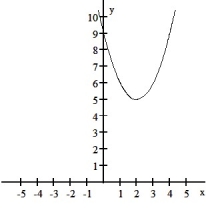


فتح الحزمة
افتح القفل للوصول البطاقات البالغ عددها 178 في هذه المجموعة.
فتح الحزمة
k this deck
46
The following graph represents the result of applying a sequence of transformations to the graph of a basic function. Identify the basic function and describe the transformation(s). Write the equation for the given graph. 


فتح الحزمة
افتح القفل للوصول البطاقات البالغ عددها 178 في هذه المجموعة.
فتح الحزمة
k this deck
47
Graph the function.
-
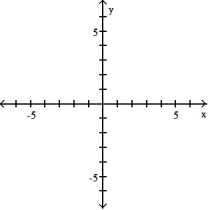
A)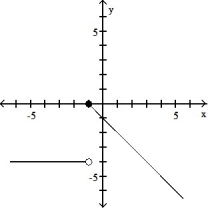
B)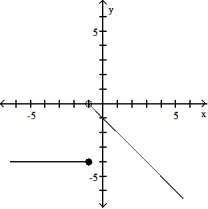
C)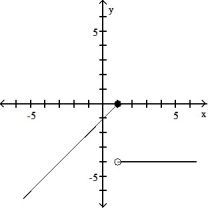
D)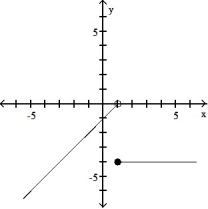
-


A)

B)

C)

D)


فتح الحزمة
افتح القفل للوصول البطاقات البالغ عددها 178 في هذه المجموعة.
فتح الحزمة
k this deck
48
Graph the function.
-f(x) =

A)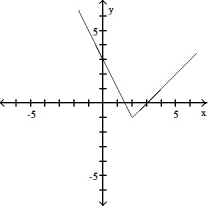
B)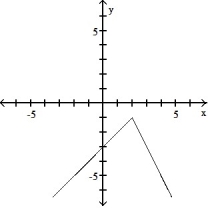
C)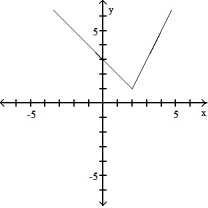
D)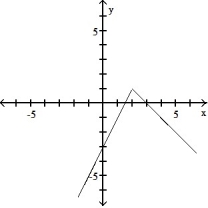
-f(x) =


A)

B)

C)

D)


فتح الحزمة
افتح القفل للوصول البطاقات البالغ عددها 178 في هذه المجموعة.
فتح الحزمة
k this deck
49
Assume it costs 25 cents to mail a letter weighing one ounce or less, and then 20 cents for each additional ounce or fraction of an ounce. Let L(x) be the cost of mailing a letter weighing x ounces. Graph y = L(x). Use the interval (0, 4].
A)![<strong>Assume it costs 25 cents to mail a letter weighing one ounce or less, and then 20 cents for each additional ounce or fraction of an ounce. Let L(x) be the cost of mailing a letter weighing x ounces. Graph y = L(x). Use the interval (0, 4].</strong> A) B) C) D)](https://d2lvgg3v3hfg70.cloudfront.net/TB10044/11ee70a7_3a7c_ca95_b147_4561e5e09463_TB10044_11.jpg)
B)![<strong>Assume it costs 25 cents to mail a letter weighing one ounce or less, and then 20 cents for each additional ounce or fraction of an ounce. Let L(x) be the cost of mailing a letter weighing x ounces. Graph y = L(x). Use the interval (0, 4].</strong> A) B) C) D)](https://d2lvgg3v3hfg70.cloudfront.net/TB10044/11ee70a7_3a7c_ca96_b147_2f924420ae04_TB10044_00.jpg)
C)![<strong>Assume it costs 25 cents to mail a letter weighing one ounce or less, and then 20 cents for each additional ounce or fraction of an ounce. Let L(x) be the cost of mailing a letter weighing x ounces. Graph y = L(x). Use the interval (0, 4].</strong> A) B) C) D)](https://d2lvgg3v3hfg70.cloudfront.net/TB10044/11ee70a7_3a7c_ca97_b147_77bc02d4a8b8_TB10044_11.jpg)
D)![<strong>Assume it costs 25 cents to mail a letter weighing one ounce or less, and then 20 cents for each additional ounce or fraction of an ounce. Let L(x) be the cost of mailing a letter weighing x ounces. Graph y = L(x). Use the interval (0, 4].</strong> A) B) C) D)](https://d2lvgg3v3hfg70.cloudfront.net/TB10044/11ee70a7_3a7c_ca98_b147_1b06f139c46e_TB10044_11.jpg)
A)
![<strong>Assume it costs 25 cents to mail a letter weighing one ounce or less, and then 20 cents for each additional ounce or fraction of an ounce. Let L(x) be the cost of mailing a letter weighing x ounces. Graph y = L(x). Use the interval (0, 4].</strong> A) B) C) D)](https://d2lvgg3v3hfg70.cloudfront.net/TB10044/11ee70a7_3a7c_ca95_b147_4561e5e09463_TB10044_11.jpg)
B)
![<strong>Assume it costs 25 cents to mail a letter weighing one ounce or less, and then 20 cents for each additional ounce or fraction of an ounce. Let L(x) be the cost of mailing a letter weighing x ounces. Graph y = L(x). Use the interval (0, 4].</strong> A) B) C) D)](https://d2lvgg3v3hfg70.cloudfront.net/TB10044/11ee70a7_3a7c_ca96_b147_2f924420ae04_TB10044_00.jpg)
C)
![<strong>Assume it costs 25 cents to mail a letter weighing one ounce or less, and then 20 cents for each additional ounce or fraction of an ounce. Let L(x) be the cost of mailing a letter weighing x ounces. Graph y = L(x). Use the interval (0, 4].</strong> A) B) C) D)](https://d2lvgg3v3hfg70.cloudfront.net/TB10044/11ee70a7_3a7c_ca97_b147_77bc02d4a8b8_TB10044_11.jpg)
D)
![<strong>Assume it costs 25 cents to mail a letter weighing one ounce or less, and then 20 cents for each additional ounce or fraction of an ounce. Let L(x) be the cost of mailing a letter weighing x ounces. Graph y = L(x). Use the interval (0, 4].</strong> A) B) C) D)](https://d2lvgg3v3hfg70.cloudfront.net/TB10044/11ee70a7_3a7c_ca98_b147_1b06f139c46e_TB10044_11.jpg)

فتح الحزمة
افتح القفل للوصول البطاقات البالغ عددها 178 في هذه المجموعة.
فتح الحزمة
k this deck
50
If f(x) =  , what is the definition of g(x), the function whose graph is obtained by shifting f(x)'s graph right 5 units and down 1 unit?
, what is the definition of g(x), the function whose graph is obtained by shifting f(x)'s graph right 5 units and down 1 unit?
 , what is the definition of g(x), the function whose graph is obtained by shifting f(x)'s graph right 5 units and down 1 unit?
, what is the definition of g(x), the function whose graph is obtained by shifting f(x)'s graph right 5 units and down 1 unit?
فتح الحزمة
افتح القفل للوصول البطاقات البالغ عددها 178 في هذه المجموعة.
فتح الحزمة
k this deck
51
A retail chain sells washing machines. The retail price p(x) (in dollars) and the weekly demand x for a particular model are related by the function p(x) = 625 - 5  , where 50 x 500. (i) Describe how the graph of the function p can be obtained from the graph of one of the six basic functions: y = x,
, where 50 x 500. (i) Describe how the graph of the function p can be obtained from the graph of one of the six basic functions: y = x, 
 y =
y =  , y =
, y =  , or y =
, or y =  . (ii) Sketch a graph of function p using part (i) as an aid.
. (ii) Sketch a graph of function p using part (i) as an aid. 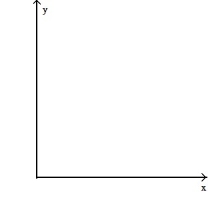
A)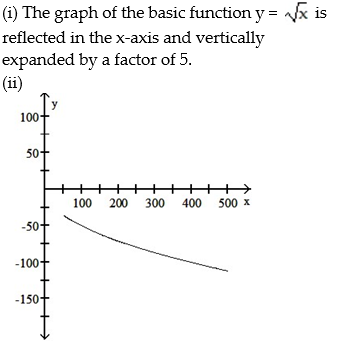
B)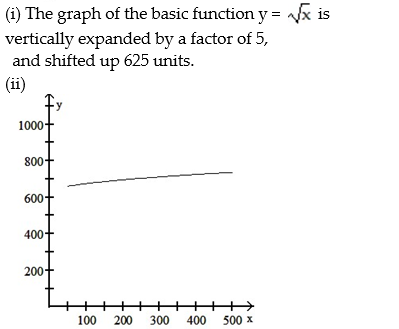
C)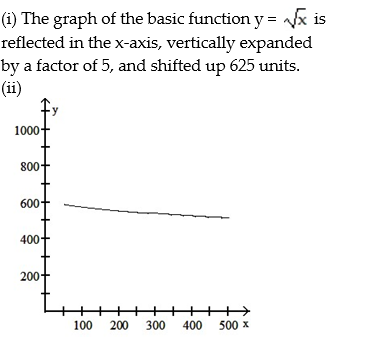
D)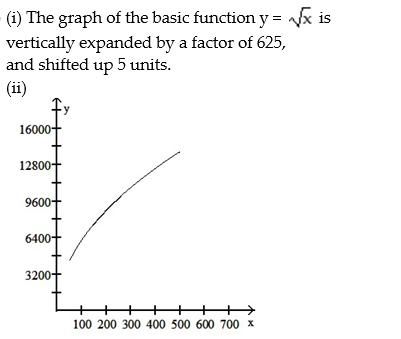
 , where 50 x 500. (i) Describe how the graph of the function p can be obtained from the graph of one of the six basic functions: y = x,
, where 50 x 500. (i) Describe how the graph of the function p can be obtained from the graph of one of the six basic functions: y = x, 
 y =
y =  , y =
, y =  , or y =
, or y =  . (ii) Sketch a graph of function p using part (i) as an aid.
. (ii) Sketch a graph of function p using part (i) as an aid. 
A)

B)

C)

D)


فتح الحزمة
افتح القفل للوصول البطاقات البالغ عددها 178 في هذه المجموعة.
فتح الحزمة
k this deck
52
The following table shows a recent state income tax schedule for married couples filing a joint return in State X. 
(i) Write a piecewise definition for the tax due T(x) on an income of x dollars. (ii) Graph T(x). (iii) Find the tax due on a taxable income of $50,000. Of $95,000.
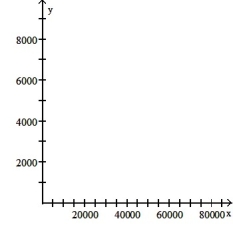
A)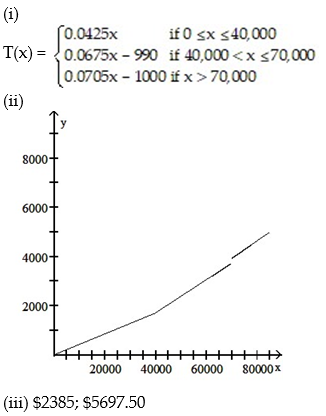
B)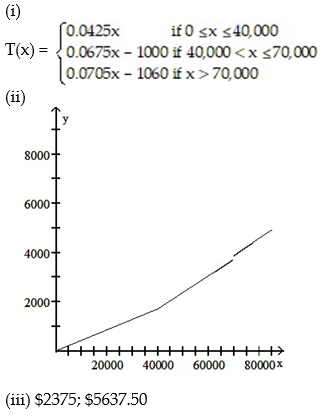
C)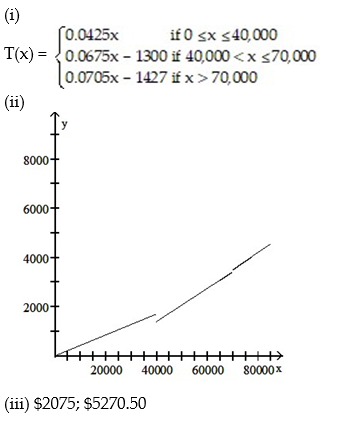
D)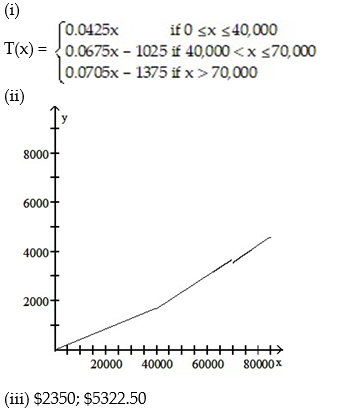

(i) Write a piecewise definition for the tax due T(x) on an income of x dollars. (ii) Graph T(x). (iii) Find the tax due on a taxable income of $50,000. Of $95,000.

A)

B)

C)

D)


فتح الحزمة
افتح القفل للوصول البطاقات البالغ عددها 178 في هذه المجموعة.
فتح الحزمة
k this deck
53
The average weight of a particular species of frog is given by w(x) = 98  , 0.1 x 0.3, where x is length (with legs stretched out) in meters and w(x) is weight in grams. (i) Describe how the graph of function w can be obtained from one of the six basic functions: y = x,
, 0.1 x 0.3, where x is length (with legs stretched out) in meters and w(x) is weight in grams. (i) Describe how the graph of function w can be obtained from one of the six basic functions: y = x,  ,
,  y =
y =  , y =
, y =  , or y =
, or y =  . (ii) Sketch a graph of function w using part (i) as an aid.
. (ii) Sketch a graph of function w using part (i) as an aid. 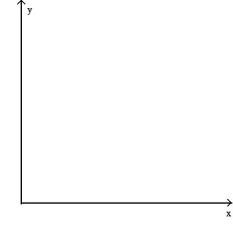
A)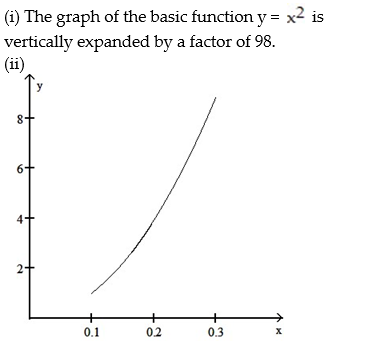
B)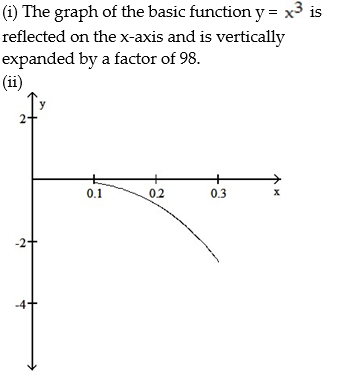
C)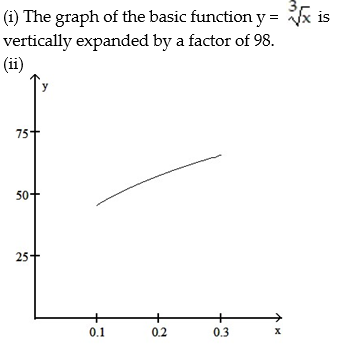
D)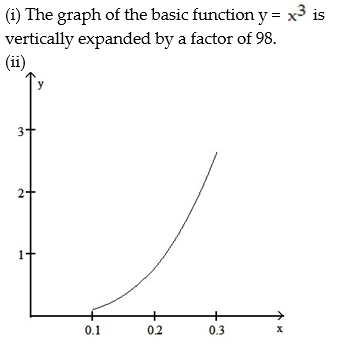
 , 0.1 x 0.3, where x is length (with legs stretched out) in meters and w(x) is weight in grams. (i) Describe how the graph of function w can be obtained from one of the six basic functions: y = x,
, 0.1 x 0.3, where x is length (with legs stretched out) in meters and w(x) is weight in grams. (i) Describe how the graph of function w can be obtained from one of the six basic functions: y = x,  ,
,  y =
y =  , y =
, y =  , or y =
, or y =  . (ii) Sketch a graph of function w using part (i) as an aid.
. (ii) Sketch a graph of function w using part (i) as an aid. 
A)

B)

C)

D)


فتح الحزمة
افتح القفل للوصول البطاقات البالغ عددها 178 في هذه المجموعة.
فتح الحزمة
k this deck
54
Find the x-intercept(s) if they exist:
-
A)
B) 10, -5
C) -1, -5
D) 1 , 5
-

A)

B) 10, -5
C) -1, -5
D) 1 , 5

فتح الحزمة
افتح القفل للوصول البطاقات البالغ عددها 178 في هذه المجموعة.
فتح الحزمة
k this deck
55
Find the x-intercept(s) if they exist:
-
A) 21
B) 0
C) 0, 7
D) 7
-

A) 21
B) 0
C) 0, 7
D) 7

فتح الحزمة
افتح القفل للوصول البطاقات البالغ عددها 178 في هذه المجموعة.
فتح الحزمة
k this deck
56
For the given function, find each of the following:
(A) Intercepts
(B) Vertex
(C) Maximum or minimum
(D) Range
-
A) (A) x-intercepts: - 7, -1; y-intercept: 7
(B) Vertex ( -4, -9)
(C) Minimum: -9
(D) y -9
B) (A) x-intercepts: 1, 7; y-intercept: 7
(B) Vertex ( -4, -9)
(C) Minimum: -9
(D) y -9
C) (A) x-intercepts: - 7, -1; y-intercept: 7
(B) Vertex ( -4, -9)
(C) Maximum: -9
(D) y -9
D) (A) x-intercepts: - 7, -1; y-intercept: 7
(B) Vertex ( 4, -9)
(C) Minimum: -9
(D) y -9
(A) Intercepts
(B) Vertex
(C) Maximum or minimum
(D) Range
-

A) (A) x-intercepts: - 7, -1; y-intercept: 7
(B) Vertex ( -4, -9)
(C) Minimum: -9
(D) y -9
B) (A) x-intercepts: 1, 7; y-intercept: 7
(B) Vertex ( -4, -9)
(C) Minimum: -9
(D) y -9
C) (A) x-intercepts: - 7, -1; y-intercept: 7
(B) Vertex ( -4, -9)
(C) Maximum: -9
(D) y -9
D) (A) x-intercepts: - 7, -1; y-intercept: 7
(B) Vertex ( 4, -9)
(C) Minimum: -9
(D) y -9

فتح الحزمة
افتح القفل للوصول البطاقات البالغ عددها 178 في هذه المجموعة.
فتح الحزمة
k this deck
57
For the given function, find each of the following:
(A) Intercepts
(B) Vertex
(C) Maximum or minimum
(D) Range
-
A) (A) x-intercepts: -4, 2; y-intercept: -8
(B) Vertex ( 1, -9)
(C) Minimum: -9
(D) y -9
B) (A) x-intercepts: - 2, 4; y-intercept: -8
(B) Vertex ( 1, -9)
(C) Maximum: -9
(D) y -9
C) (A) x-intercepts: - 2, 4; y-intercept: -8
(B) Vertex ( 1, -9)
(C) Minimum: -9
(D) y -9
D) (A) x-intercepts: - 2, 4; y-intercept: -8
(B) Vertex ( -1, -9)
(C) Minimum: -9
(D) y -9
(A) Intercepts
(B) Vertex
(C) Maximum or minimum
(D) Range
-

A) (A) x-intercepts: -4, 2; y-intercept: -8
(B) Vertex ( 1, -9)
(C) Minimum: -9
(D) y -9
B) (A) x-intercepts: - 2, 4; y-intercept: -8
(B) Vertex ( 1, -9)
(C) Maximum: -9
(D) y -9
C) (A) x-intercepts: - 2, 4; y-intercept: -8
(B) Vertex ( 1, -9)
(C) Minimum: -9
(D) y -9
D) (A) x-intercepts: - 2, 4; y-intercept: -8
(B) Vertex ( -1, -9)
(C) Minimum: -9
(D) y -9

فتح الحزمة
افتح القفل للوصول البطاقات البالغ عددها 178 في هذه المجموعة.
فتح الحزمة
k this deck
58
For the given function, find each of the following:
(A) Intercepts
(B) Vertex
(C) Maximum or minimum
(D) Range
-
A) (A) x-intercepts: - 5, -1; y-intercept: -5
(B) Vertex ( -3, 4)
(C) Minimum: 4
(D) y 4
B) (A) x-intercepts: - 5, -1; y-intercept: -5
(B) Vertex ( 3, -4)
(C) Maximum: 4
(D) y 4
C) (A) x-intercepts: - 5, -1; y-intercept: -5
(B) Vertex ( -3, 4)
(C) Maximum: 4
(D) y 4
D) (A) x-intercepts: 1, 5; y-intercept: -5
(B) Vertex ( -3, 4)
(C) Maximum: 4
(D) y 4
(A) Intercepts
(B) Vertex
(C) Maximum or minimum
(D) Range
-

A) (A) x-intercepts: - 5, -1; y-intercept: -5
(B) Vertex ( -3, 4)
(C) Minimum: 4
(D) y 4
B) (A) x-intercepts: - 5, -1; y-intercept: -5
(B) Vertex ( 3, -4)
(C) Maximum: 4
(D) y 4
C) (A) x-intercepts: - 5, -1; y-intercept: -5
(B) Vertex ( -3, 4)
(C) Maximum: 4
(D) y 4
D) (A) x-intercepts: 1, 5; y-intercept: -5
(B) Vertex ( -3, 4)
(C) Maximum: 4
(D) y 4

فتح الحزمة
افتح القفل للوصول البطاقات البالغ عددها 178 في هذه المجموعة.
فتح الحزمة
k this deck
59
For the given function, find each of the following:
(A) Intercepts
(B) Vertex
(C) Maximum or minimum
(D) Range
-
A) (A) x-intercepts: 1, 5; y-intercept: -5
(B) Vertex ( 3, 4)
(C) Minimum: 4
(D) y 4
B) (A) x-intercepts: -5, - 1; y-intercept: -5
(B) Vertex ( 3, 4)
(C) Maximum: 4
(D) y 4
C) (A) x-intercepts: 1, 5; y-intercept: -5
(B) Vertex ( -3, -4)
(C) Maximum: 4
(D) y 4
D) (A) x-intercepts: 1, 5; y-intercept: -5
(B) Vertex ( 3, 4)
(C) Maximum: 4
(D) y 4
(A) Intercepts
(B) Vertex
(C) Maximum or minimum
(D) Range
-

A) (A) x-intercepts: 1, 5; y-intercept: -5
(B) Vertex ( 3, 4)
(C) Minimum: 4
(D) y 4
B) (A) x-intercepts: -5, - 1; y-intercept: -5
(B) Vertex ( 3, 4)
(C) Maximum: 4
(D) y 4
C) (A) x-intercepts: 1, 5; y-intercept: -5
(B) Vertex ( -3, -4)
(C) Maximum: 4
(D) y 4
D) (A) x-intercepts: 1, 5; y-intercept: -5
(B) Vertex ( 3, 4)
(C) Maximum: 4
(D) y 4

فتح الحزمة
افتح القفل للوصول البطاقات البالغ عددها 178 في هذه المجموعة.
فتح الحزمة
k this deck
60
Find the vertex form for the quadratic function. Then find each of the following:
(A) Intercepts
(B) Vertex
(C) Maximum or minimum
(D) Range
-
A)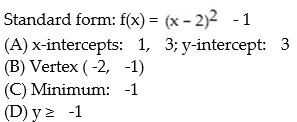
B)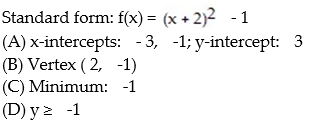
C)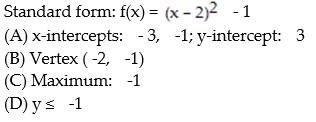
D)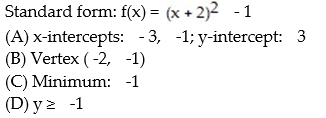
(A) Intercepts
(B) Vertex
(C) Maximum or minimum
(D) Range
-

A)

B)

C)

D)


فتح الحزمة
افتح القفل للوصول البطاقات البالغ عددها 178 في هذه المجموعة.
فتح الحزمة
k this deck
61
Find the vertex form for the quadratic function. Then find each of the following:
(A) Intercepts
(B) Vertex
(C) Maximum or minimum
(D) Range
-
A)
B)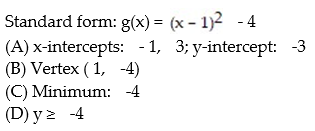
C)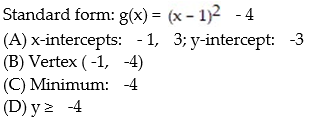
D)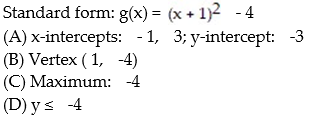
(A) Intercepts
(B) Vertex
(C) Maximum or minimum
(D) Range
-

A)

B)

C)

D)


فتح الحزمة
افتح القفل للوصول البطاقات البالغ عددها 178 في هذه المجموعة.
فتح الحزمة
k this deck
62
Find the vertex form for the quadratic function. Then find each of the following:
(A) Intercepts
(B) Vertex
(C) Maximum or minimum
(D) Range
-
A)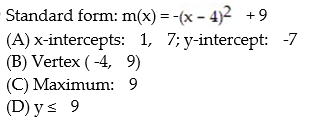
B)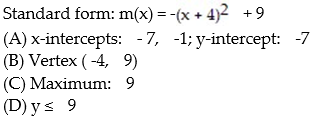
C)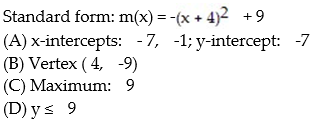
D)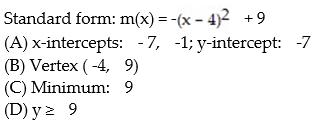
(A) Intercepts
(B) Vertex
(C) Maximum or minimum
(D) Range
-

A)

B)

C)

D)


فتح الحزمة
افتح القفل للوصول البطاقات البالغ عددها 178 في هذه المجموعة.
فتح الحزمة
k this deck
63
Find the vertex form for the quadratic function. Then find each of the following:
(A) Intercepts
(B) Vertex
(C) Maximum or minimum
(D) Range
-
A)
B)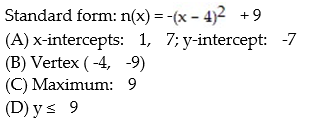
C)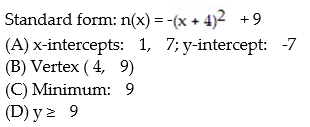
D)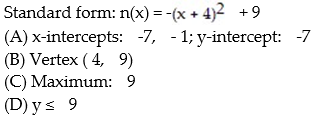
(A) Intercepts
(B) Vertex
(C) Maximum or minimum
(D) Range
-

A)

B)

C)

D)


فتح الحزمة
افتح القفل للوصول البطاقات البالغ عددها 178 في هذه المجموعة.
فتح الحزمة
k this deck
64
Determine whether there is a maximum or minimum value for the given function, and find that value:
-
A) Maximum: 10
B) Minimum: 4
C) Minimum: 0
D) Maximum: -4
-

A) Maximum: 10
B) Minimum: 4
C) Minimum: 0
D) Maximum: -4

فتح الحزمة
افتح القفل للوصول البطاقات البالغ عددها 178 في هذه المجموعة.
فتح الحزمة
k this deck
65
Determine whether there is a maximum or minimum value for the given function, and find that value:
-
A) Minimum: 0
B) Minimum: -9
C) Maximum: - 9
D) Minimum: 9
-

A) Minimum: 0
B) Minimum: -9
C) Maximum: - 9
D) Minimum: 9

فتح الحزمة
افتح القفل للوصول البطاقات البالغ عددها 178 في هذه المجموعة.
فتح الحزمة
k this deck
66
Find the range of the given function. Express your answer in interval notation:
-![<strong>Find the range of the given function. Express your answer in interval notation: - </strong> A) (- \infty , -3] B) [3, \infty ) C) (- \infty , 2] D) [ - 2, \infty )](https://d2lvgg3v3hfg70.cloudfront.net/TB10044/11ee70a7_3a7e_5074_b147_71cbecedfcbf_TB10044_11.jpg)
A) (- , -3]
B) [3, )
C) (- , 2]
D) [ - 2, )
-
![<strong>Find the range of the given function. Express your answer in interval notation: - </strong> A) (- \infty , -3] B) [3, \infty ) C) (- \infty , 2] D) [ - 2, \infty )](https://d2lvgg3v3hfg70.cloudfront.net/TB10044/11ee70a7_3a7e_5074_b147_71cbecedfcbf_TB10044_11.jpg)
A) (- , -3]
B) [3, )
C) (- , 2]
D) [ - 2, )

فتح الحزمة
افتح القفل للوصول البطاقات البالغ عددها 178 في هذه المجموعة.
فتح الحزمة
k this deck
67
Find the range of the given function. Express your answer in interval notation:
-![<strong>Find the range of the given function. Express your answer in interval notation: - </strong> A) [-3, \infty ) B) (- \infty , -3] C) [5, \infty ) D) (- \infty , -5]](https://d2lvgg3v3hfg70.cloudfront.net/TB10044/11ee70a7_3a7e_5075_b147_fb86745a57e3_TB10044_11.jpg)
A) [-3, )
B) (- , -3]
C) [5, )
D) (- , -5]
-
![<strong>Find the range of the given function. Express your answer in interval notation: - </strong> A) [-3, \infty ) B) (- \infty , -3] C) [5, \infty ) D) (- \infty , -5]](https://d2lvgg3v3hfg70.cloudfront.net/TB10044/11ee70a7_3a7e_5075_b147_fb86745a57e3_TB10044_11.jpg)
A) [-3, )
B) (- , -3]
C) [5, )
D) (- , -5]

فتح الحزمة
افتح القفل للوصول البطاقات البالغ عددها 178 في هذه المجموعة.
فتح الحزمة
k this deck
68
Find the vertex and the maximum or minimum of the quadratic function  by first writing f in standard form. State the range of f and find the intercepts of f .
by first writing f in standard form. State the range of f and find the intercepts of f .
 by first writing f in standard form. State the range of f and find the intercepts of f .
by first writing f in standard form. State the range of f and find the intercepts of f .
فتح الحزمة
افتح القفل للوصول البطاقات البالغ عددها 178 في هذه المجموعة.
فتح الحزمة
k this deck
69
Graph  and indicate the maximum or minimum value of f(x), whichever exists.
and indicate the maximum or minimum value of f(x), whichever exists.
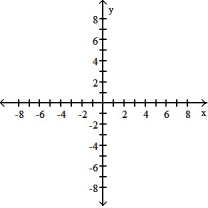
 and indicate the maximum or minimum value of f(x), whichever exists.
and indicate the maximum or minimum value of f(x), whichever exists.

فتح الحزمة
افتح القفل للوصول البطاقات البالغ عددها 178 في هذه المجموعة.
فتح الحزمة
k this deck
70
Write an equation for the graph in the form y = a + k, where a is either 1 or -1 and h and k are integers:
-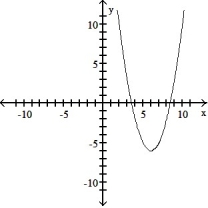
A)
B)
C)
D)
-

A)

B)

C)

D)


فتح الحزمة
افتح القفل للوصول البطاقات البالغ عددها 178 في هذه المجموعة.
فتح الحزمة
k this deck
71
Write an equation for the graph in the form y = a + k, where a is either 1 or -1 and h and k are integers:
-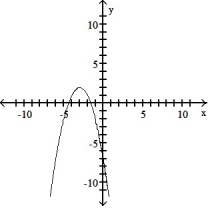
A)
B)
C)
D)
-

A)

B)

C)

D)


فتح الحزمة
افتح القفل للوصول البطاقات البالغ عددها 178 في هذه المجموعة.
فتح الحزمة
k this deck
72
Solve graphically to two decimal places using a graphing calculator:
-
A) -0.93 < x < 2.46
B) x < -2.46 or x > 0.93
C) x < -0.93 or x > 2.46
D) -2.46 < x < 0.93
-

A) -0.93 < x < 2.46
B) x < -2.46 or x > 0.93
C) x < -0.93 or x > 2.46
D) -2.46 < x < 0.93

فتح الحزمة
افتح القفل للوصول البطاقات البالغ عددها 178 في هذه المجموعة.
فتح الحزمة
k this deck
73
Solve graphically to two decimal places using a graphing calculator:
-
A) x < -3.66 or x > 0.53
B) x < -0.53 or x > 3.66
C) -3.66 < x < 0.53
D) -0.53 < x < 3.66
-

A) x < -3.66 or x > 0.53
B) x < -0.53 or x > 3.66
C) -3.66 < x < 0.53
D) -0.53 < x < 3.66

فتح الحزمة
افتح القفل للوصول البطاقات البالغ عددها 178 في هذه المجموعة.
فتح الحزمة
k this deck
74
Solve the equation graphically to four decimal places:
-
A) No solution
B) -0.4341
C) -0.4341, 3.2912
D) 3.2912
-

A) No solution
B) -0.4341
C) -0.4341, 3.2912
D) 3.2912

فتح الحزمة
افتح القفل للوصول البطاقات البالغ عددها 178 في هذه المجموعة.
فتح الحزمة
k this deck
75
Solve the equation graphically to four decimal places:
-
A) No solution
B) -2.6235, 7.6235
C) -2.6235
D) 7.6235
-

A) No solution
B) -2.6235, 7.6235
C) -2.6235
D) 7.6235

فتح الحزمة
افتح القفل للوصول البطاقات البالغ عددها 178 في هذه المجموعة.
فتح الحزمة
k this deck
76
Solve the equation graphically to four decimal places:
-
A) 2.5000, 4.7500
B) 2.5000
C) 4.7500
D) No solution
-

A) 2.5000, 4.7500
B) 2.5000
C) 4.7500
D) No solution

فتح الحزمة
افتح القفل للوصول البطاقات البالغ عددها 178 في هذه المجموعة.
فتح الحزمة
k this deck
77
For the following problem, (i) graph f and g in the same coordinate system; (ii) solve f(x) = g(x) algebraically to two decimal places; (iii) solve f(x) > g(x) using parts i and ii; (iv) solve f(x) < g(x) using parts i and ii.
-f(x) = -0.8x(x - 8), g(x) = 0.4x + 3.2; 0 ? x ? 10
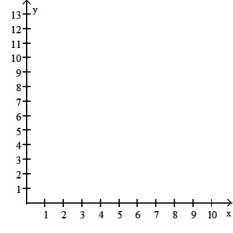
A)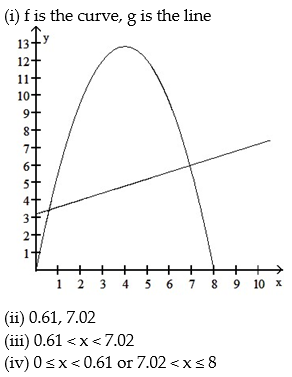
B)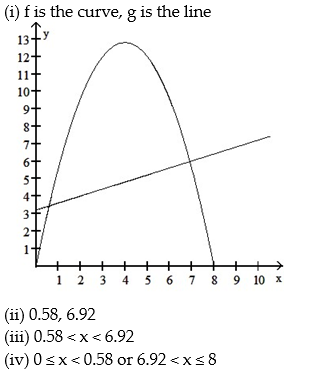
C)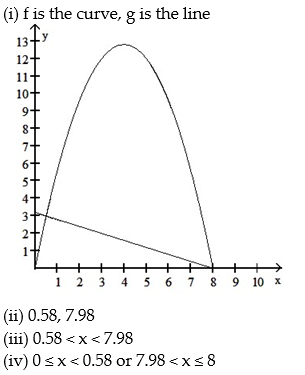
D)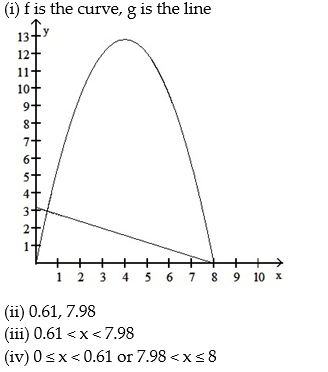
-f(x) = -0.8x(x - 8), g(x) = 0.4x + 3.2; 0 ? x ? 10

A)

B)

C)

D)


فتح الحزمة
افتح القفل للوصول البطاقات البالغ عددها 178 في هذه المجموعة.
فتح الحزمة
k this deck
78
In economics, functions that involve revenue, cost and profit are used. Suppose R(x) and C(x) denote the total revenue and the total cost, respectively, of producing a new high-tech widget. The difference  represents the total profit for producing x widgets. Given R(x) = 60x - 0.4
represents the total profit for producing x widgets. Given R(x) = 60x - 0.4  and
and  find the equation for P(x).
find the equation for P(x).
A)
B)
C)
D)
 represents the total profit for producing x widgets. Given R(x) = 60x - 0.4
represents the total profit for producing x widgets. Given R(x) = 60x - 0.4  and
and  find the equation for P(x).
find the equation for P(x).A)

B)

C)

D)


فتح الحزمة
افتح القفل للوصول البطاقات البالغ عددها 178 في هذه المجموعة.
فتح الحزمة
k this deck
79
In economics, functions that involve revenue, cost and profit are used. Suppose R(x) and C(x) denote the total revenue and the total cost, respectively, of producing a new high-tech widget. The difference  represents the total profit for producing x widgets. Given R(x) = 60x - 0.4
represents the total profit for producing x widgets. Given R(x) = 60x - 0.4  and
and  find P(100).
find P(100).
A) 55687
B) 313
C) 2000
D) 1687
 represents the total profit for producing x widgets. Given R(x) = 60x - 0.4
represents the total profit for producing x widgets. Given R(x) = 60x - 0.4  and
and  find P(100).
find P(100).A) 55687
B) 313
C) 2000
D) 1687

فتح الحزمة
افتح القفل للوصول البطاقات البالغ عددها 178 في هذه المجموعة.
فتح الحزمة
k this deck
80
A professional basketball player has a vertical leap of 37 inches. A formula relating an athlete's vertical leap V, in inches, to hang time T, in seconds, is V=  . What is his hang time? Round to the nearest tenth.
. What is his hang time? Round to the nearest tenth.
A) 1 sec
B) 0.6 sec
C) 0.9 sec
D) 0.8 sec
 . What is his hang time? Round to the nearest tenth.
. What is his hang time? Round to the nearest tenth.A) 1 sec
B) 0.6 sec
C) 0.9 sec
D) 0.8 sec

فتح الحزمة
افتح القفل للوصول البطاقات البالغ عددها 178 في هذه المجموعة.
فتح الحزمة
k this deck








